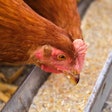
Are feed mills and grain handling facilities likely to be a major terrorist threat? “Probably not,” says Dr. Leland McKinney, extension state leader, Department of Grain Science and Industry, Kansas State University. But that said, McKinney advises companies to take “common sense precautions,” such as doing employee background checks and limiting access to company sites.
Bio-terrorism safeguards
In a Kansas State University study of feed mills and ethanol plants, the conclusion was that many “have very little protection” against bioterrorism.
But the industry has taken actions to reduce the odds of a biological terrorism attack, McKinney comments. For example, “it used to be that anybody could walk into a warehouse. Now you have to check in.” In addition, he says, most plants have good quality control testing.
If bioterrorists have their minds set on planting something that will damage the food system, they are less likely to attack an indirect link to food such as feed mills, but are more likely to make their attacks directly on foods, such as vegetables and milk, McKinney says.
He continues that there are ways the industry could be made safer, such as having guards that everyone must pass through to enter the site, or surveillance cameras, but the reality is that at this point they are probably not cost effective.
New biosecurity threats
But just because the feed industry is less likely than other industries to be a target for bioterrorism, doesn’t mean it should be sanguine about it.
Looking at the agriculture industry in total, “The likelihood of terrorist acts interrupting the production, processing, and distribution of agricultural products is high: A number of different possible plant or animal pathogens could cause harm or loss of production, and even an act of agroterrorism that did not result in the destruction of foodstuffs or interruptions in the food supply could have a psychological impact,” states an article by O Shawn Cupp, David E. Walker II, and John Hillison.
“Agriculture is one of the easiest sectors of the U.S. economy to disrupt, and its disruption could have catastrophic consequences for the U.S. and world economies,” the article continues.
According to the American Feed Industry Association (AFIA), “one should not assume that consumers are a terrorist’s sole targets. Grain, processed ingredients, animal feed and pet food and their delivery vehicles all serve as potential vectors intentional contamination, resulting in injury to humans and animals. The “time is right” for promoting biosecurity for the feed industry, AFIA continues.
Creating a HAACP plan
The biggest biosecurity threats to the industry today likely come from the inside an operation, such as a disgruntled employee, McKinney says, and that’s difficult to have a system to prevent.
Today, McKinney says, most biosecurity incidents that occur are accidents, although he notes that the recent melamine contamination “was intentional.”
One way to reduce the chance that feed could become contaminated, McKinney comments, is through the use of a Hazard Analysis Critical Control Points (HACCP) plan.
A HACCP plan for the feed industry contains the following principles:
- Hazard analysis
- Identifying critical control points
- Establishing critical limits
- Establishing monitoring procedures
- Establishing corrective actions
- Establishing verification procedures
- Establishing record keeping procedures
Support for HAACP in Mexico
HACCP has more support in countries outside the United States. For instance, McKinney recently conducted a workshop for the feed industry in Mexico “and they were very much for it.”
According to McKinney, it’s important for feed mills to protect against: mycotoxins, salmonella, and e coli. However, here are all kinds of outside substances that can enter plants that can be harmful, such as PCBs—fire retardards—that accidentally were put into feed in the 1970s.
One advantage the feed industry has, McKinney states, is that feed has to go through animals before it reaches consumers “and animals are a pretty good filter.” He notes, however, that alfatoxins, “if fed to dairy cattle can result in a hazard.”
Reducing contamination risks
There are ways feed plants can reduce the odds of contamination. For example, he says, meat and bone meal should not be used in plants that make feed for ruminants because of the risk of mad cow disease. And nicarbizan should not be used in plants that make feed for layers because if it gets into the layer feed it could result in weakened egg shells.
According AFIA, certain safe substances may be used to produce unsafe or harmful combinations if used incorrectly or indiscriminately. These include ammonium nitrate or urea fertilizer, concentrated pesticides, and animal drugs. AFIA advises feed plants “to secure and account for such products and report anyone acting suspiciously or wishing to purchase abnormal quantities.
Here are four key ways feed can before adulterated:
- Biological (bacteria, toxins, viruses, parasites, etc.);
- Chemical (classical chemical warfare agents, such as nerve, blister, blood and choking, and toxic industrial chemicals, such as pesticides, rodenticides and heavy metals);
- Radiological (agents that can be delivered in liquid or solid form; and
- Physical (e.g. ferrous and non-ferrous metal, glass, and plastic.
Any biosecurity program should anticipate attempts to introduce those agents into the animal feed production and distribution process.



.jpg?auto=format%2Ccompress&fit=crop&h=167&q=70&w=250)
(1).jpg?auto=format%2Ccompress&fit=crop&h=167&q=70&w=250)












